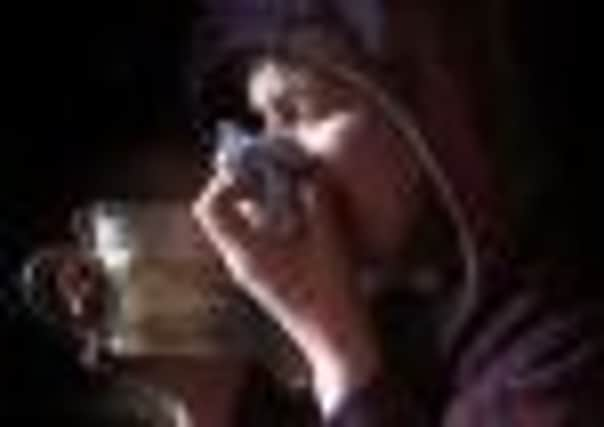It might come as a blow, it might put you on your back


Time to close the door and retreat under the covers for at least a week – you’ve got flu.
And, as you lie in bed, cursing the grey Scottish weather and wishing you were somewhere far warmer, you can take comfort from knowing the bug that’s probably making you feel so bad at least boasts an exotic and well-travelled name.
Advertisement
Hide AdAdvertisement
Hide AdThe US sunshine state of California, Western Australia’s baking hot metropolis, Perth, and the Queensland tourist favourite, Brisbane, might sound like fabulous places to visit, but if the flu bugs that bear their names strike as predicted this winter, then the only place you’re heading is straight to bed.
The World Health Organisation (WHO) has identified three particular flu strains likely to descend at any time now: two A type influenza strains, one, a swine flu called California A H1N1, the other Perth AH3N2 and a B strain known as Brisbane.
And it doesn’t matter how fit and healthy you might otherwise be, any one of them with all its head-pounding, stomach churning, body-pummelling nastiness will leave sufferers flattened.
However, should you happen to be among those battling another condition, perhaps weakened by heart trouble, managing asthma or just happily pregnant, flu could be a far greater enemy than just a niggling winter bug that lays you low.
Advertisement
Hide AdAdvertisement
Hide AdAstonishing then, that last year only around half of the 80,000 or so individuals in Lothian considered to be in the most “at risk” groups actually signed up for the flu jab.
“Flu is a serious condition, and if people are susceptible and are in the at-risk group then we really do want them to go and get immunised,” says Dr Dermot Gorman, Lothian NHS public health consultant.
“It’s possible some groups become complacent, perhaps they’re fairly fit with a small touch of asthma and they don’t see a flu jab as a big priority. They might think it’s a trivial thing, but it’s far better to be immunised than take the chance.”
Certainly, it seems the stakes are high. Last year’s flu outbreak – which brought a host of viral nasties including swine flu – claimed 602 lives in the UK, 63 of them in Scottish hospitals.
Advertisement
Hide AdAdvertisement
Hide AdIn one single week in January alone, flu claimed the lives of 17 Scots. The real figures, however, are thought to be even higher when deaths in the community are taken into consideration.
Perhaps one of the most worrying elements of the statistics was that around 70 per cent of the fatalities were among young to middle aged adults, those in the 15-to-64 age group, not typically thought to be at highest risk from a bout of flu.
Harrowing, too, were the deaths of 25 children, aged just four to 14, a further 16 aged between one and four and, nine babies who failed to even reach their first birthday.
But if the statistics aren’t alarming enough, yesterday came further worrying news for pregnant women – one of the groups already considered most at risk from swine flu, one of three bugs which this year’s vaccine is designed to protect against.
Last year, nine pregnant women lost their lives to the bug.
Advertisement
Hide AdAdvertisement
Hide AdNow a study carried out by the National Perinatal Epidemiology Unit at Oxford University has shown those who contract swine flu and then go on to give birth have a higher risk of having a stillbirth or delivering a baby with birth defects.
Researchers followed 256 pregnant women infected with the H1n1 swine flu virus between September 2009 and January 2010 and found seven babies stillborn and three died shortly after birth.
That, they discovered, works out at the equivalent of 39 in 1000 babies dying before or shortly after birth – compared to just seven in 1000 women not infected with the virus.
This year, WHO has predicted the three key flu bugs – California and Perth A strains and B strain Brisbane – and included them in the single vaccination jab.
Advertisement
Hide AdAdvertisement
Hide AdIt is free to everyone over 65 and the estimated 80,000 Lothian patients who fall into the at-risk groups – pregnant women, patients with conditions like asthma, diabetes, cystic fibrosis, multiple sclerosis and heart, lung and liver diseases.
The jab is also free to carers and NHS workers dealing directly with patients – although last year only around 26 per cent of NHS front-line staff took up the vaccination offer.
For the rest of us, local chemists and branches of the Co-operative Pharmacy, Lloyds and Boots have launched their own vaccination services. A flu jag at a pharmacy will cost around £10. The question, however, is whether the rest of us needs it?
“From a public health perspective, what’s most important of all is that the people who are most at risk are protected,” says Dr Gorman.
Advertisement
Hide AdAdvertisement
Hide Ad“It’s vital that people are immunised so there aren’t outbreaks among those who are already seriously ill or in nursing homes and hospital.
“Also, there might not be that much spare vaccine going around to immunise everyone else. So I wouldn’t necessarily recommend people go and pay for jabs.
“It’s true that flu can be quite random and can strike very fit and healthy people who have no underlying conditions, but that is quite rare,” he adds. “And we have no indication that there is any particularly nasty strain of flu coming.”
Instead, he recommends the rest of us simply take sensible precautions, keep hands clean and use disposable tissues. And if the flu strikes, rest at home and try not to spread it.
“But for those who are vulnerable and at risk, it’s better to have the vaccination as soon as possible.”
n For further information, go to www.nhslothian.scot.nhs.uk or www.immunisationscotland.org.uk.